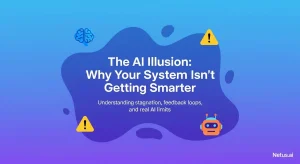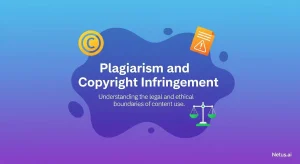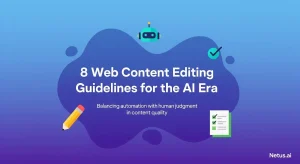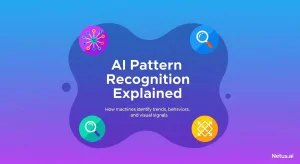Avoid and Check Duplicate Content: Effective Strategies for Content Creators
Ashley Merit
Content writer and editor for Netus.AI
Table of Contents
Avoid and Check Duplicate Content. In modern times, online presence has become essential for businesses, making it crucial to have a well-structured and plagiarism-free website. As physical meetings become less common, customers rely on a company’s digital presence to determine its credibility. Thus, ensuring original content on a website or blog is an important factor to maintain the organization’s reputation.
Duplicate content not only damages a company’s image, but it can also have indirect consequences. The relationship between duplicate content and search engine optimization (SEO) is significant in this context. Websites with identical content can experience decreased SEO rankings, leading to less traffic and ultimately affecting the business. Therefore, it is imperative for companies to avoid duplicate content, whether they have in-house writers or hire freelancers. Utilizing a website plagiarism checker can be beneficial in ensuring the content is original and free from duplication.
Key Takeaways
- Maintaining a plagiarism-free website is crucial for establishing credibility and trust among customers.
- Duplicate content can negatively impact a website’s SEO ranking, leading to reduced traffic and diminished business.
- Companies should utilize a website plagiarism checker to ensure original content, regardless of whether they have in-house writers or hire freelancers.
What Is Duplicate Content?
Duplicate content refers to instances where the same material is present on multiple web addresses or URLs. This can happen for various reasons, either technical or manual, but the outcome remains consistent: such content negatively impacts a website’s SEO ranking. As such, it is essential for writers and content creators to utilize a duplicate content checker to avoid potential issues.
Duplicate content can appear in two main forms. First, the same piece of content might exist in several locations on a single website. Second, a particular article might be accessible through different navigation paths, such as appearing in multiple categories or sections. Some key factors to consider when distinguishing duplicate content include:
- Whether the content is appreciably similar or identical to existing material
- If it could be deemed deceptive or plagiarism
- How it compares to unique content or original content
The presence of duplicate content on a website may indicate low-quality, deceptive origins, or even instances of syndication, scraping, or copying from other sources. It is crucial to address these issues promptly to maintain SEO performance and uphold the integrity of your content.
How Does Duplicate Content Affect SEO?
Duplicate content can negatively impact a website’s SEO performance as search engines like Google prioritize improving user experience by eliminating duplicate information. Although no specific penalty is imposed for having duplicate content, it can result in lowered website rankings, causing the site not to appear at the top of search results. This reduction in visibility leads to decreased organic traffic, hindering the organization’s ability to nurture and convert these visitors into leads.
There are several negative consequences associated with duplicate content impacting SEO rankings:
- Link Equity: Duplicate content causes search engines to struggle with allocating link metrics such as trust, authority, and backlinks among different versions of the same content.
- Crawl Budget: Search engine crawlers may waste resources on duplicate pages, reducing their ability to discover new, unique content on the site.
- Search Engine Rankings: As mentioned earlier, duplicate content can lower the website’s visibility, leading to a drop in search engine rankings and organic traffic.
Hence, for better SEO performance and overall user experience, it’s crucial to address and resolve any duplicate content issues on the website.
What Are the Reasons for Duplicate Content Creation?
There are several factors that contribute to the creation of duplicate content, which may occur unintentionally by website owners or deliberately by those looking to bulk up their content. Some of the common causes of duplicate content include:
- Multiple URL variations: Duplicate content can emerge when a website has several web page addresses with the same content, such as variations of HTTP, HTTPS, and www.
- Use of scraped content: Many websites, particularly in the e-commerce sector, use scraped or copied content to create bulk articles, such as republishing previously published articles, blogs, or editorials. E-commerce site developers often incorporate manufacturer and product details as scraped content.
- Unique locations with the same content: Duplicate content may be unintentionally created when specific content is assigned to two different unique locations or URLs. Various factors like click tracking and analytics code can lead to duplicate content issues.
Being aware of these potential duplicate content triggers is essential for website owners to maintain the integrity of their sites. Regularly checking for duplicate content can help prevent issues arising from content duplication and maintain a website’s credibility.
Best Ways to Avoid Duplicate Content?
To effectively prevent duplicate content, consider implementing these strategies:
- Utilize 301 redirects: When multiple pages contain similar content, a 301 redirect can guide users to the original page. Modify the .htaccess file to include these redirects.
- Implement rel=”canonical” tags: Add this tag to the HTML head of a page, indicating that it is the original source of the content. Search engines will credit the canonized website with all relevant links.
- Secure Google Authorship: Establishing authorship can protect content from being copied or scraped. Signing your name on your content indicates ownership and can prevent plagiarism.
- Adjust parameters and preferred domain settings: Accurately setting these options informs search engines of the primary web page that should be considered for ranking when there are multiple versions of the same content.
Additional measures include using WordPress plugins for better content management, implementing noindex meta tags on specific pages that should be excluded from search engine indexing, and employing pagination and sorting techniques to ensure proper organization of content. Through these approaches, website owners can maintain the integrity and uniqueness of their content in a clear and concise manner.
Find Duplicate Content on Your Site:
To ensure your website’s content is unique, utilize a duplicate content checker that scans, compares, and detects similar content on your site. This tool generates detailed results, identifying links to copied content. Web developers can then take the necessary steps to eliminate duplicate content.
In addition to duplicate content checkers, you can use tools like Google Search Console and Google Webmaster Tools to analyze your website’s URLs and track potential duplicate content issues. Be cautious of URL variations, such as HTTP and HTTPS, as well as trailing slashes, as these can lead to duplicate content.
Remember to periodically check for duplicate content using these tools, and maintain a consistent website address structure so that your site rankings aren’t negatively impacted.
Frequently Asked Questions
How can duplicate content issues on a website be identified?
There are several tools available to help detect duplicate content issues on your website. Some popular options include:
- Site crawlers: Tools like Screaming Frog and Sitebulb can help identify duplicates by crawling your site and analyzing the content.
- SEO tools: Platforms like Ahrefs and SEMrush offer site audit features that check for duplicate content across your web pages.
- Google Search Console: Google’s URL Inspection Tool helps discover duplicate content issues by inspecting individual URLs and detecting potential issues.
What are the primary causes of duplicate content in SEO?
Common causes of duplicate content issues in SEO include:
- Multiple versions of a page: When different URLs point to similar or identical content (e.g.,
https://example.com/andhttps://example.com/index.html). - Improper pagination: Listing product categories or blog posts across multiple pages without proper configuration can lead to duplicate content.
- URL variations: Parameters in the URL, such as sorting options, can cause search engines to see similar pages as duplicates.
- Content syndication: Sharing the same content across multiple websites without using canonical tags can create duplicate content.
What tactics can help prevent duplicate content problems?
To prevent duplicate content issues, consider implementing the following strategies:
- Use canonical tags: Including a rel=”canonical” tag on each page points search engines to the original content and reduces the risk of duplication.
- 301 redirects: Redirecting multiple versions of a URL to a single, preferred version (301 redirect) ensures that search engines index the correct page.
- Configure URL parameters in Google Search Console: Let Google know how to handle URL parameters to avoid indexing duplicate content.
- Proper pagination: Use rel=”next” and “rel=”prev” tags to create a clear relationship between paginated pages.
How does duplicate content influence search engine rankings?
Duplicate content can negatively impact search engine rankings because:
- It confuses search engine algorithms by presenting multiple versions of the same content.
- It may lead to lower indexation of all duplicate pages, causing them to miss out on potential search visibility.
- It could dilute backlink authority between multiple versions of the same content, weakening the overall link profile.
How should duplicate content from multiple domains be addressed?
When resolving duplicate content across various domains:
- Request the other site owner to add a canonical tag, pointing to the original content on your website.
- Consider setting up a cross-domain canonical tag if you are the owner of both domains.
- If necessary, submit a DMCA takedown request via Google to address copyright violations.
Can canonical tags alleviate duplicate content issues?
Yes, using canonical tags can help eliminate the problem of duplicate content by telling search engines which version of the content is the original or preferred one. This way, search engines can consolidate the ranking signals and prevent dilution of authority over multiple versions of the same content.

The shortcomings of content generated by AI | NetusAI
Discover why fast, high-volume AI content often fails to deliver real results. Learn about the crucial missing feedback loop and how implementing performance tracking can transform your AI content strategy.

The illusion of AI: Your system's intelligence gap | NetusAI
Stop wasting marketing spend! Most AI tools don’t learn from results, causing content stagnation and low engagement. Discover why your generative AI isn’t getting smarter and what system actually learns and optimizes content.

Plagiarism and copyright infringement | NetusAI
Learn the distinct differences between plagiarism and copyright infringement. Understand the ethical and legal implications and get practical strategies for avoiding both academic and creative work with NetusAI.

Tips and strategies for mobile content marketing | NetusAI
Optimized for mobile-first indexing, learn 5 essential strategies to capture attention, enhance engagement and drive leads and sales with your mobile content marketing.

Web content editing guidelines for the AI era | NetusAI
Review web content editing guidelines for the AI era. Learn how to edit AI-generated content, ensure authenticity and optimize for SEO and readability.

Explaining AI pattern recognition | NetusAI
AI pattern recognition enables machines to identify trends for diverse applications, from detecting plagiarism to fraud. Discover its processes, models and real-world benefits.
